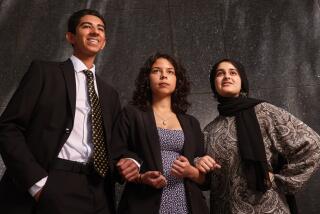Children in Arizona Town Touched by Cancer Cluster
- Share via
SIERRA VISTA, Ariz. — Jessica Durkit looked sickly. She bruised easily, struggled to get over infections and seemed to be constantly at the pediatrician’s office.
“She just existed. She was just there,” said her mother, Kelley Durkit.
Then, in late 2001, a spider bite sent Jessica, then 2, to the emergency room. Her foot was badly swollen. But hospital staff worried about something else -- something they saw in Jessica’s blood.
She had leukemia. And she wasn’t alone.
Other children in her southern Arizona community of about 40,000 had been diagnosed with the cancer, and more would follow.
In all, 10 children in the Sierra Vista area have been diagnosed with childhood leukemia since 1995, more than twice the previously observed rate. The most recent diagnosis in the cancer cluster was made last year.
Two of the children have died. The others, including Jessica, are in remission.
Another three cases of leukemia have been counted among children who lived here but moved before being diagnosed, said Dr. Tim Flood, who is the medical director for Arizona public health statistics.
Determining that Sierra Vista was the site of a cluster was a slow process. Parents were the first to raise questions.
University Medical Center in Tucson has southern Arizona’s only pediatric oncology treatment facility, and as parents passed time in waiting rooms, they began to chat. It turned out that a fair number were from Sierra Vista, and that got Tucson mother Tricia Olma curious.
She began to ask questions and gather other parents, eventually founding Families Against Cancer and Toxins.
“I stood alone” initially, said Olma, who was concerned that so many children from a small town seemed to be in treatment.
At first, the cluster seemed borderline. It was unclear whether it was statistically significant, said Cochise County epidemiologist Dr. Gary Spivey.
“We had to wrestle with the boundary issues,” he said, noting the small number of cases and sprawling area.
Jessica Durkit was one of the cases that tipped the scale.
“We didn’t even know how to spell ‘leukemia’ at the time,” said her father, Dale Durkit.
The little girl, now a giggly kindergartner, underwent seven months of chemotherapy. She endured countless shots and pills while her pregnant mother stayed at the Ronald McDonald House next to University Medical Center and her father, a heavy equipment operator at Ft. Huachuca, commuted back and forth.
Jessica, whose straight brown hair has grown shoulder length, has been cancer-free since her treatment.
Although their daughter is now in remission, the Durkits and others are anxious for answers -- to understand whether something in the environment here is responsible for the illnesses.
Public health officials say that is an answer they’re unlikely to find.
Hundreds of studies on cancer clusters in particular geographic areas have been done over the years, but none has yielded a direct cause.
That includes an intensive study done in Fallon, Nev., and surrounding Churchill County. Twelve children living in the county have been diagnosed since 1997; the latest diagnosis was disclosed Dec. 20. Fallon is just one-fifth the size of Sierra Vista.
Many of the same theories about what caused the leukemia cases in Fallon were raised in Sierra Vista. Both are military towns (a naval air station in Fallon and an Army fort in Sierra Vista), so questions about jet fuel surfaced.
Both desert communities also have high concentrations of the metal tungsten, according to University of Arizona researcher Mark Witten. Tungsten isn’t thought to be a cancer-causing agent, but little study has been done.
Beverly Kingsley, an epidemiologist with the Centers for Disease Control and Prevention, said public health workers would like to be able to determine the origin of the Sierra Vista cluster, but studying cases grouped by geography was tough.
There are countless variables and people’s memories about what they have and haven’t been exposed to are faulty, she said.
The other problem is that sometimes clusters are just coincidences -- the result of chance, she said.
Kingsley acknowledges, though, that such explanations can be difficult for parents and affected communities.
“We’re scientists. Most of us are parents.... Sure, I understand these people just want answers. It’s terrible for these children,” she said. “I understand the perspective.”
The CDC is taking some action in Sierra Vista, though. It has trained county workers to take samples of blood, urine and cheek cells from families of those who are sick and from others who live here.
They will be tested for known contaminants, like benzene. Some samples will be banked for future testing as technology and knowledge about the disease improve, Kingsley said.
Cochise County health workers have taken test samples and hope to begin collecting real samples from 21 families this month, said Rita Weatherholt, spokeswoman for the Cochise County health department.
But Dale Durkit said the biosampling seemed useless.
“To us, it seems like a huge waste of time to make people happy. They’re just going to blow through here,” he said.
Tiesha Hutchens, mother of the most recently diagnosed child in the cluster, said she was most concerned that people in the community be made aware about what was going on.
“I don’t know there’s anything that can be done besides the acknowledgment of the information out there,” said Hutchens, who wears a yellow Lance Armstrong “LiveStrong” bracelet. Her 2-year-old daughter, M.J., was diagnosed in October 2003 and is still undergoing chemotherapy, although she is in remission.
Hutchens had some vague knowledge about the cancer cases when she moved to Sierra Vista in early 2002, already pregnant with M.J.
“We never did drink the water,” Hutchens said.
Still, when M.J. became anemic and suddenly had a lot of bruises, Hutchens had no idea that could be cancer.
The toddler was diagnosed immediately and began chemotherapy within days.
Hutchens now lives in Tucson, but friends in Sierra Vista tell her that some parents still don’t know about the leukemia cluster.
“They’re still in disbelief, I guess.”
*
(BEGIN TEXT OF INFOBOX)
Tracking clusters
What is a cluster?
It is generally defined as an unusual number of cases of a certain disease within a certain area. The determination of a cluster is done by public health officials, who compare current numbers to the historical rate. It can be difficult, though, because often officials are dealing with a small total number.
When is it a fluke?
Clusters are determined by comparing cases to historical rates, but those are averages. There will be times when a group of cases will show up, followed by years of none. This is particularly true of rare diseases, such as childhood leukemia. The cluster may just be the result of coincidence -- similar to a run of heads or a run of tails when you flip a coin. The odds of flipping heads or tails are the same, but sometimes there will be a grouping of one or the other.
How can officials find a cause?
Finding causes in geographic clusters is extremely difficult. Public health officials can look for known cancer-causing agents, but once those are eliminated, the search becomes difficult. There are too many variables, and researchers must rely on people’s recollections, which can be faulty. Cluster studies of workplace environments are usually more successful because the environment -- and therefore the variables -- is more controlled.
Source: Associated Press
Los Angeles Times
More to Read
Sign up for Essential California
The most important California stories and recommendations in your inbox every morning.
You may occasionally receive promotional content from the Los Angeles Times.










